Sea anemone
| Sea anemone | ||||||||||
|---|---|---|---|---|---|---|---|---|---|---|
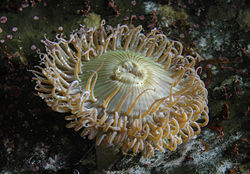 Sea anemone at the Monterey Bay Aquarium
|
||||||||||
| Scientific classification | ||||||||||
|
||||||||||
| Diversity | ||||||||||
| 46 families | ||||||||||
| Suborders | ||||||||||
|
Endocoelantheae |

Sea anemones are a group of water dwelling, predatory animals of the order Actiniaria; they are named after the anemone, a terrestrial flower. As cnidarians, sea anemones are closely related to corals, jellyfish, tube-dwelling anemones, and Hydra.
Contents |
Anatomy
A sea anemone is a small sac, attached at the bottom to the surface beneath it by an adhesive foot, called a basal disc, with a column shaped body ending in an oral disc. The mouth is in the middle of the oral disc, surrounded by tentacles armed with many cnidocytes, which are cells that function as a defense and as a means to capture prey. Cnidocytes contain cnidae, capsule-like organelles capable of everting, giving phylum Cnidaria its name [1]. The cnidae that sting are called nematocysts. Each nematocyst contains a small vesicle filled with toxins—actinoporins—an inner filament and an external sensory hair. When the hair is touched, it mechanically triggers the cell explosion, a harpoon-like structure which attaches to organisms that trigger it, and injects a dose of poison in the flesh of the aggressor or prey. This gives the anemone its characteristic sticky feeling.
The poison is a mix of toxins, including neurotoxins, which paralyze the prey, which is then moved by the tentacles to the mouth/anus for digestion inside the gastrovascular cavity. Actinoporins have been reported as highly toxic to fish and crustaceans, which may be the natural prey of sea anemones. In addition to their role in predation, it has been suggested that actinoporins could act, when released in water, as repellents against potential predators. Clownfish are not affected by their host anemone's sting.[2]
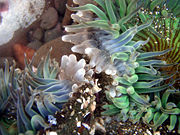
The internal anatomy of anemones is simple. There is a gastrovascular cavity (which functions as a stomach) with a single opening to the outside which functions as both a mouth and an anus: waste and undigested matter is excreted through the mouth/anus, which can be described as an incomplete gut. A primitive nervous system, without centralization, coordinates the processes involved in maintaining homeostasis as well as biochemical and physical responses to various stimuli. Anemones range in size from less than 1¼ cm (½ in) to nearly 2 m (6 ft) in diameter.[3] They can have a range of 10 tentacles to hundreds.

The muscles and nerves in anemones are much simpler than those of other animals. Cells in the outer layer (epidermis) and the inner layer (gastrodermis) have microfilaments grouped together into contractile fibers. These are not true muscles because they are not freely suspended in the body cavity as they are in more developed animals. Since the anemone lacks a skeleton, the contractile cells pull against the gastrovascular cavity, which acts as a hydrostatic skeleton. The stability for this hydrostatic skeleton is caused by the anemone shutting its mouth, which keeps the gastrovascular cavity at a constant volume, making it more rigid.
Exploitation
The global trade in marine ornamentals is an expanding industry. In the early 1980s, the estimated value of imported marine fish and invertebrates was US $24-40 million annually.[4] Current estimates place that value at US $200-330 million,[5] with the USA accounting for 80% of the industry imports.[6] Despite advances and the expansion of aquaculture, post-larval capture and rearing, the majority of marine ornamentals are collected in the wild as adults or juveniles.[7] Anemones are susceptible to overexploitation due to their long life spans, slower growth rates, and lower reproductive rates than their resident fish, which are also affected because they settle exclusively and are restricted to specific host anemones. The demand for these organisms is reflected in fishermen's catch records, which document the value they are paid per catch, and on average anemones were valued at five times the value of the average value of anemonefish, and ten times the value of the most abundant anemonefish, and in fact only made up 4.1% of the total value of the catch. Research has shown that aquarium fishing activities significantly impact the populations of anemones and anemonefish by drastically reducing the densities of each in exploited areas,[7] and could also negatively impact anemone shrimp, and any organisms obligately associated with anemones. It should be noted that anemonefish can survive alone in captivity, as has been shown by multiple research efforts.[8][9]
Ecology


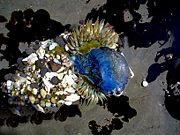
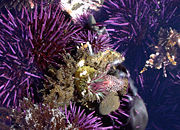
The sea anemone has a foot which in most species attaches itself to rocks or anchors in the sand. Others also burrow into a stronger object. Some species attach to kelp and others are free-swimming. Although not plants and therefore incapable of photosynthesis themselves, many sea anemones form an important facultative symbiotic relationship with certain single-celled green algae species which reside in the animals' gastrodermal cells. These algae may be either zooxanthellae, zoochlorellae, or both. The sea anemone benefits from the products of the algae's photosynthesis, namely oxygen and food in the form of glycerol, glucose, and alanine; the algae in turn are assured a reliable exposure to sunlight and protection from micro-feeders, which the anemones actively maintain. The algae also benefit by being protected due to the presence of stinging cells called nematocysts, reducing the likelihood of being eaten by herbivores. Most species inhabit tropical reefs, although there are species adapted to relatively cold waters, intertidal reefs, and sand/kelp environments.
Life cycle
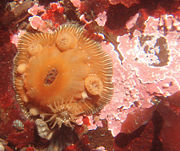


Unlike other cnidarians, anemones (and other anthozoans) entirely lack the free-swimming medusa stage of the life cycle: the polyp produces eggs and sperm, and the fertilized egg develops into a planula that develops directly into another polyp.
A few anemones are parasitic to marine organisms. Anemones tend to stay in the same spot until conditions become unsuitable (prolonged dryness, for example), or a predator is attacking them. In the case of an attack, anemones can release themselves from the substrate and swim away to a new location using flexing motions.
The sexes in sea anemones are separate for some species while some are hermaphroditic. Both sexual and asexual reproduction may occur. In sexual reproduction males release sperm which stimulates females to release eggs, and fertilization occurs. The eggs or sperm are ejected through the mouth. The fertilized egg develops into a planula, which finally settles down and grows into a single polyp. They can also reproduce asexually by budding, binary fission (which involves pulling apart into two halves), and pedal laceration, in which small pieces of the pedal disc break off and regenerate into small anemones.
Fossil record
Most Actiniaria do not form hard parts that can be recognized as fossils but a few fossils do exist; Mackenzia, from the Middle Cambrian Burgess Shale of Canada, is the oldest fossil identified as a sea anemone.
Stomphia
Stomphia is a genus of sea anemone which is called the "swimming anemone". It is very different from the rest because, though it anchors, it is able to swim away when it senses danger. On the bottom of the body is a suction cup-like part that is pushed in when the Stomphia anchors. It is then pushed out when the Stomphia needs to release itself. These anemones are able to react quickly to touch and immediately spring into action. They bounce away from the rock and away from the predator, and then swim by swinging their bodies back and forth. When the anemone is at a safe distance, it finds another rock and anchors onto it.
Gallery
References
- ↑ Campbell N. & J. Reece (2002). Biology (6th ed ed.). San Francisco: Pearson Education.
- ↑ Fagatele Bay NMS: Clownfish and Sea Anemone
- ↑ [1]
- ↑ Wood, E. 1985. "Exploitation of coral reef fishes for the aquarium trade." Report to the Marine Conservation Society. Marine Conservation Society, UK.
- ↑ Chapman, F. A.; Fitz-Coy, S. A.; Thunberg, E. M.; Adams, C. M. 1997. United States of America trade in ornamental fish. Journal of the World Aquaculture Society. Vol. 28:1–10.
- ↑ Larkin, S.L.; Degner, R.L. 2001. The U.S. wholesale market for marine ornamentals. Aquarium Sciences and Conservation. Vol. 3:13–24.
- ↑ 7.0 7.1 Shuman, C. G.; Hodgson, G.; Ambrose, R. F. 2005. "Population impacts of collecting sea anemones and anemonefish for the marine aquarium trade in the Philippines." Coral Reefs. Vol. 24:564-573.
- ↑ Fautin, Daphne Gail. 1991. “The Anemonefish Symbiosis: What is known and What is Not.” Symbiosis. Vol. 10:23-46.
- ↑ Shimek, R. (2004), p. 83. Marine Invertebrates. T.F.H. Publications, Inc. Neptune City, NJ.
External links
- Order Actiniaria
- Actiniaria.com
- Photos of various species of Sea Anemones from the Indopacific
- Anemone Armies Battle to a Standoff
- Anemone Wars: Clone armies deploy scouts, attack tidally - unsuspected military tactics
- Sea anemones look like sea flowers but they are animals of the Phylum Cnidaria
- Information about Ricordea Florida Sea anemones & pictures